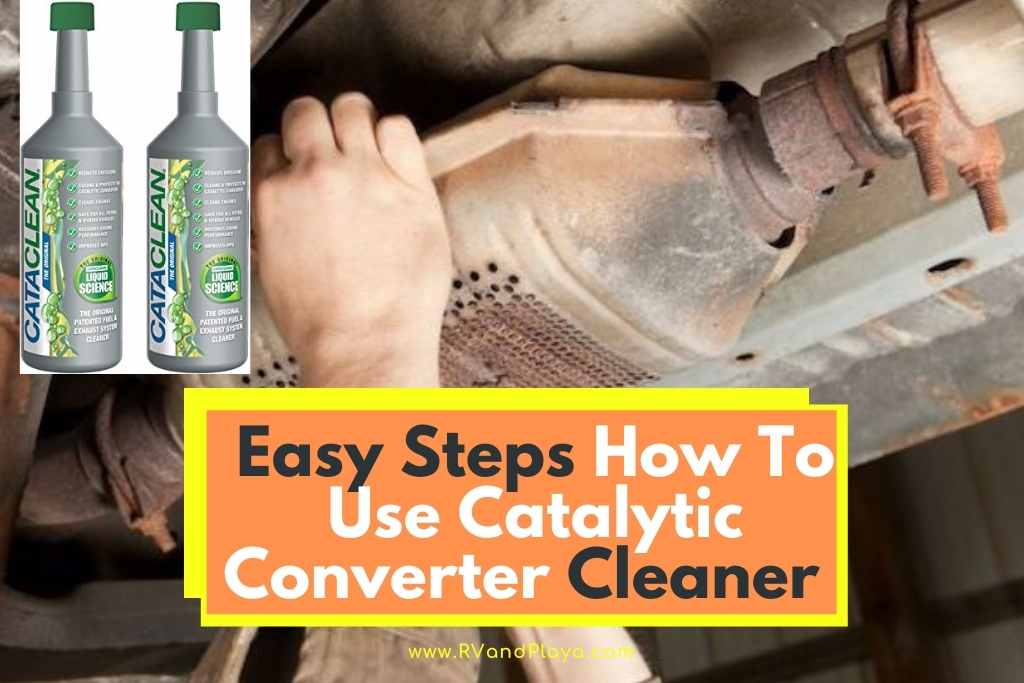Have you ever asked yourself or your friend how to use a catalytic converter cleaner like Cataclean? Well, you are at the perfect place to find the answer to such a question.
Your catalytic converter is the most environmentally important part of your vehicle, as it is responsible for converting harmful emissions into harmless and environmentally safe emissions that aren’t harmful.
So, how to use a Catalytic converter cleaner? Catalytic converter cleaner is typically poured directly into the fuel tank—although some variations can be emptied into the oil reservoir—where it will make its way through the fuel, exhaust, and catalytic converter to remove excess carbon build-ups.
To easily use a catalytic converter cleaner, just follow the steps below:
Step #0: Make sure you thoroughly read the instructions
Step #1: Remove the seal from the bottle.
Step #2: Dump all the bottle’s contents into your fuel tank.
Step #3: Drive your vehicle for at least 15 minutes to allow the Cataclean to get into your vehicle’s parts.
Step #4: If you have error codes, clear them after you’ve driven the vehicle.
Step #5: Refill your gas tank at the fuel pump. (Recommendation: ¾ full)
Step #6: If there were error codes, drive your vehicle for at least 50 miles to reset the OBDII.
As it removes excessive carbon build-up, it frees up the catalytic converter to continue doing what it does best, which is separating and converting harmful emissions into a harmless gas.
It also has the added benefit of improvising your vehicle’s performance.
Table of Contents
Steps For Using Catalytic Converter Cleaner
It’s not quite a dump-and-go process as you’ll want to make sure that your vehicle isn’t running on fumes when you pour the cleaner into the tank.
- Make sure you thoroughly read the instructions
- Fill tank to the necessary fuel requirements for the catalytic converter cleaner
- Pour the catalytic converter cleaner into your fuel tank
- Take your vehicle for a ride, making sure to rev it up occasionally
- Refill the tank
It’s important the read through the instructions because not every catalytic converter cleaner is the same. Some require a certain amount of fuel in the tank before distributing the cleaner into the fuel system.
Others may want you to completely fill up the tank. Still, others may require only a certain amount to be used per gallon of fuel in the tank.
You always have to have some level of fuel in the tank. You don’t want to empty catalytic converter cleaner into a tank that’s already running on fumes.
Your vehicle wasn’t designed to run on catalytic converter cleaner alone, after all.
Most cleaners are poured directly into the fuel tank in the same way that you gas up. In some cases, you may need a funnel with a long tube to get down into the fuel neck.
Just make sure that the funnel is clean and free of any other chemicals, oils, or residues.
The reason you take the vehicle for a good drive afterward is to work the converter cleaner into the system.
You also want to get the RPMs up whenever you can because it will help the cleaner dispel the excess carbon build-ups within the fuel and exhaust systems.
Refilling the tank after you’re done is important as well. You don’t have to fill it all the way up but you don’t want it to go back to burning fumes right after running a catalytic converter cleaner through it.
Read also: 6 Symptoms Of A Clogged Catalytic Converter (Signs Nobody Is Talking About)
Do Catalytic Converter Cleaners Work In Other Ways?
Some cleaners, such as Seafoam, are introduced via the fuel tank or directly into your oil.
It typically works in much the same way as a fuel additive, by cleaning off deposits and removing the oil poisons that find their way into your exhaust system.
In the case of Seafoam, you add one ounce of it for every quart of oil in your crankcase. That could be anywhere between 3 and six quarts.
For large engines, it could be above 6 quarts, so it’s best if you know your vehicle’s specifications beforehand.
Through your oil, it almost acts as a preventative or as an accommodation to the cleaning process in the fuel system.
Not only does it remove heavy deposits, but it also improves oil flow and lubrication, which helps your engine run better.
As engine performance improves, so does its ability to self-clean carbon deposits throughout the fuel and exhaust system.
If you also have a catalytic converter cleaner in the fuel system, it will boost the engine’s capabilities when it comes to burning off excess carbon deposits.
Read also: How Much Does it Cost to Unclog a Catalytic Converter (Replacement Cost)
What Are The Best Catalytic Converter Cleaners?
So long as your catalytic converter is not completely clogged, some of the best catalytic converter cleaners available can reverse the carbon build-ups and get your converter back to nominal conditions.
Cataclean
Cataclean remains one of the top brands and top-selling catalytic converter cleaners available. It lowers your bad emissions from a dysfunctional converter by up to 50%.
Its also safe for gas, diesel, hybrid, and flex-fuel systems.
Click the link to Amazon and get the Cataclean Today!
Cataclean also cleans more than just the catalytic converter. It reduces carbon deposits in your fuel injectors, cylinder heads, catalytic converter, and oxygen sensors.
With all of these parts clean, their performance improves along with the performance of other parts in your vehicle, creating a domino effect.
CataClean — How to Clean Catalytic Converter Video >> Check out the video below:
Oxicat
Oxicat is another excellent choice that frequently finds itself at the top of any list that defines the industry’s best catalytic converter cleaners.
Oxicat works just like Cataclean except that it has the additional benefit of long-term protection against harmful carbon build-up.
It’s a little more difficult to get your hands on than Cataclean but you should be able to find it at any local auto retailer far easier than you can online.
When it is online, it’s most likely to be available on Amazon.
Redline
Redline is a great choice when you only want to fill the gas tank up to half. It’s rated to work at its best on half a fuel tank, so you don’t have to fill the tank up all of the way.
Redline uses low-temp and high-temp detergents to efficiently clean your system of harmful deposits.
It also actively prevents corrosion in your fuel system while working to reduce carbon and other harmful deposits.
Redline advertises itself as an additive that cleans to nearly 100% efficiency when used correctly, which is twice per year.
Read also: How To Unclog a Catalytic Converter Without Removing It (Best Tips – 2 Methods)
Seafoam
Seafoam isn’t so much an active cleaner of catalytic converters as it is a preventer.
It works through either your oil or fuel system to reduce the harmful poisons and carbons that facilitate a build-up within your catalytic converter.
Seafoam can be applied through the oil or fuel systems and isn’t harmful to either. Be sure to measure it out correctly according to the ratio on the can.
Final Word
Using a catalytic converter cleaner isn’t a difficult process and it’s something that you should probably do twice a year regardless of your vehicle’s age and/or mileage.
So long as you keep the carbon deposits at bay within your fuel system, your catalytic converter should have a long and industrious life span, as well as all of the other parts that catalytic converter cleaners help.
Here are some of my favorite tools & equipment´s
Thank you for reading this article. I hope it helps you find the most recent and accurate technical and repair information for your car. Here are some tools that I use as an automotive technician and hope you´ll also find helpful.
There are affiliate links, so if you do decide to use any of them, I´ll earn a small commission. But in all honesty, these are the exact tools that I use and recommend to everyone, even my own family. (NO CRAP)
To see all my of most up-to-date recommendations, check out this resource that I made for you!
References
https://www.wrcbtv.com/story/41629789/check-out-these-5-steps-on-how-to-use-cataclean
https://oards.com/best-catalytic-converter-cleaners/
Recent Posts
Which Cars Are Most Likely to Have a Catalytic Converter Stolen (Catalytic Converter Theft)
When we think of thieves targeting vehicles, we usually think of them targeting high-value, high end luxury cars and SUVs that they can chop up or flip. Very rarely do we think about thieves...
What Happens When The Catalytic Converter Goes Bad (Symptoms)
Have you ever asked yourself or your friend what happens when the catalytic converter goes bad? Well, you are at the perfect place to find the answer to such a question. The catalytic converter in...


